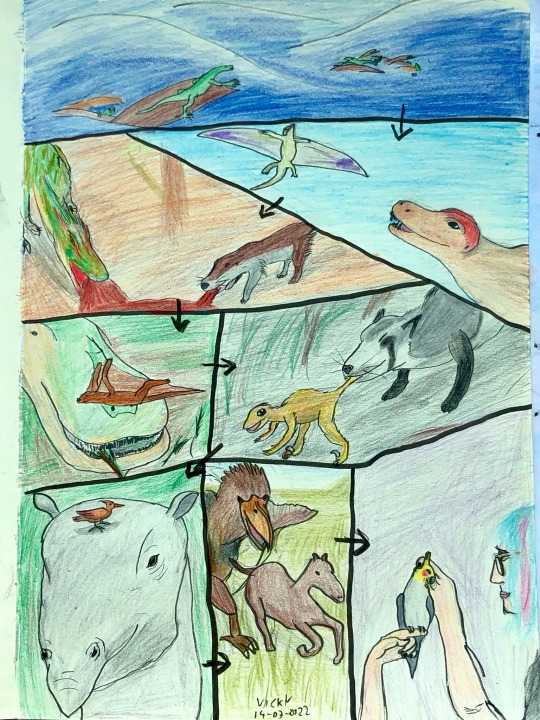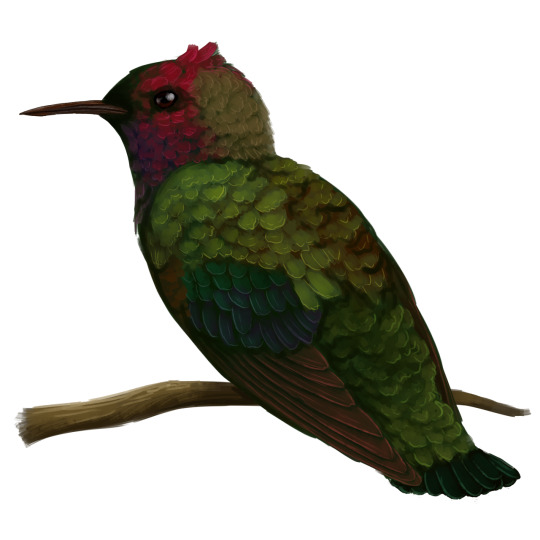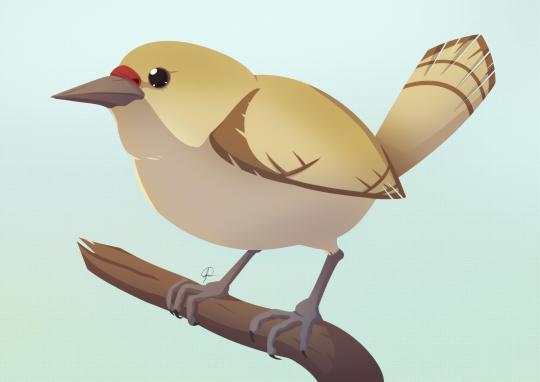#picavus
Text

A long, long time ago, back in the Carboniferous, one species of little amniotes was split in two. As their paths diverged, one group’s descendants became the sauropsids - such as reptiles, birds, and other dinosaurs - and the other group’s descendants became the synapsids - such as therapsids, cynodonts, and mammals. As the millions of years stretched on, our two clades have shared the same planet and lived alongside each other as each evolved into ever new and fascinating forms.
(in every panel, there’s a sauropsid on the left and a synapsid on the right)
-In the Permian, a Titanophoneus looks up in wonder as a Weigeltisaurus glides overhead.
-In the Triassic, a Coelophysis and a Kataigidodon cautiously share a bite of a large piece of carrion they both found.
-In the Jurassic, a Maiopatagium glides around a feeding Mamenchisaurus, hunting the insects attracted by the huge sauropod.
-In the Cretaceous, a Didelphodon captures a young Bambiraptor.
-In the Paleogene, a Picavus rests for a moment on the head of a Paraceratherium.
-In the Neogene, a Titanis hunts a Cormohipparion.
-In the Quaternary, a human gives her pet cockatiel scritches.
#synapsid#sauropsid#reptile#dinosaur#bird#evolution#amniote#titanophoneus#weigeltisaurus#coelophysis#kataigidodon#maiopatagium#mamenchisaurus#didelphodon#bambiraptor#picavus#paraceratherium#titanis#terror bird#cormohipparion#human#cockatiel#i based the coelophysis and didelphodon coloration on walking with dinosaurs#but gave the coelophysis feathers#also as you can see i drew titanis way too fat at first and had inked it before i noticed my mistake#human is based mostly on myself#though i do not have a cockatiel#(yet?)#paleoart#my art
63 notes
·
View notes
Text
Eurotrochilus

By Scott Reid
Etymology: European Hummingbird
First Described By: Mayr, 2004
Classification: Dinosauromorpha, Dinosauriformes, Dracohors, Dinosauria, Saurischia, Eusaurischia, Theropoda, Neotheropoda, Averostra, Tetanurae, Orionides, Avetheropoda, Coelurosauria, Tyrannoraptora, Maniraptoromorpha, Maniraptoriformes, Maniraptora, Pennaraptora, Paraves, Eumaniraptora, Averaptora, Avialae, Euavialae, Avebrevicauda, Pygostaylia, Ornithothoraces, Euornithes, Ornithuromorpha, Ornithurae, Neornithes, Neognathae, Neoaves, Strisores, Daedalornithes, Apodiformes, Trochilidae
Referred Species: E. inexpectatus, E. noniewiczi
Status: Extinct
Time and Place: Between 31 and 28 million years ago, in the Rupelian of the Oligocene


Eurotrochilus is known from the Menilite Formation, the Bott-Eder Grube Unterfeld, and Le Grand Banc locations across Poland, Germany, and France

Physical Description: Eurotrochilus is a bird that is remarkable precisely because, to us, it is utterly unremarkable. Put in a clearer way, Eurotrochilus is almost identical to living Hummingbirds - but it’s thirty million years old. An extremely small bird, Eurotrochilus had wings shaped like hummingbirds - small, triangular, and built for hovering flight. It was about nine centimeters in length, making it as big as living hummingbirds like the Ruby-Throated Hummingbird. In addition to having small, triangular wings, Eurotrochilus had tiny legs, like living Hummingbirds, and a very long beak. So, its identical nature to living hummingbirds points to the hummingbird body plan as an ancient one, that hasn’t been improved upon much during the Cenozoic era. Still, it wasn’t a true hummingbird yet - aka in the group that contains modern hummingbirds and those more closely related to one sort than the other - because it still had long finger bones, and smaller connections between those bones. So, while the general hummingbird shape was present for thirty million years, it still had some modifications left to go.
Diet: With its very long, specialized bill, Eurotrochilus would have fed on nectar, like living hummingbirds.
Behavior: We can be fairly confident that Eurotrochilus was capable of hovering, and did so with some regularity; it would hover near flowers and rarely perch on them while gathering nectar up with its long beak. The beak would go into the center of the flower to draw up nectar, and in the process Eurotrochilus would pick up pollen. Then, upon going to the next flower to drink more nectar, Eurotrochilus would drop off the pollen, thus helping the flowers to reproduce. It would have spent most of its time hovering, and when not hovering would rest on branches or in more foliage-filled areas. It would have been a fairly active animal, and loud as well, making a variety of chirps and calls to one another. They probably would have been very brightly colored, like living hummingbirds, and the males probably wouldn’t have been very involved in nest care.

By Ripley Cook
Ecosystem: Eurotrochilus primarily lived in forested areas, near lagoons, lakes, and estruary-filled areas. These lush habitats were filled with a variety of flowering plants for Eurotrochilus to feed on, and the forests were densely populated with birches, oaks, cypresses, conifers, palms, roses, asterids, and beeches. Eurotrochilus was a common site in these environments, which featured a variety of birds that resembled living forms and yet, were not quite like their modern counterparts. In the Bott-Eder environment of Germany, a coastal bay area, Eurotrochilus lived with birds such as the barbet Rupelramphastoides, the buttonquail Turnipax, the tody Palaeotodus, the mousebird Oligocolius, the trogon Primotrogon, the loon Colymboides, the seabird Rueplornis, and the songbird Wieslochia. This is a notable environment with a variety of transitional tree and ocean going birds, making it a fascinating habitat in which to study the evolution of dinosaurs in the Cenozoic. There were also sea cows, bats, and a Hyaenodont Apterodon, though Eurotrochilus would have been so small its unlikely that the Hyaenodont would have posed a problem for it. In the dense lake environment of Menilite, Eurotrochilus lived with the passerines Jamna, Resoviaornis, and Winnicavis, as well as the woodpecker Picavus. Here there was an extensive amount of thermal activity, which would negatively affect the ecosystem with gas bubbles and oil wells. In the lagoon environment of Le Grand, there was also Primotrogon, the early cuckoo Eocuculus, the crane Parvigrus, and the stem-passerine Zygodactylus.
Other: As the oldest representative of a proper, nectar-eating hummingbird shape, Eurotrochilus is vital for our understanding of the evolution of hummingbirds. In fact, its presence points to the idea that flowers pollinated by birds co-evolved with hummingbirds in the Eastern Hemisphere, even though hummingbirds aren’t present on that side of the globe today. Hummingbirds like Eurotrochilus, however, disappeared from that half of the globe during tropical climate collapse in Europe and the effects of the ice age. Interestingly enough, they were replaced in the Eastern Hemisphere by Sunbirds, a group of passerines that convergently evolved similar adaptations for hovering and nectar-eating, and also brightly colored feathers.
Species Differences: The two species of Eurotrochilus mainly differ on the proportions of the limbs, with E. noniewiczi having longer upper arm bones than E. inexpecattus, but shorter lower arm bones. They lived at the same time and fairly close to each other, so this difference is important in telling apart the varying kinds of these early hummingbirds.
~ By Meig Dickson
Sources Under the Cut
Bochenski, Zygmunt; Bochenski, Zbigniew (19 December 2007). "An Old World hummingbird from the Oligocene: a new fossil from Polish Carpathians". Journal of Ornithology. 149 (2): 211
Bochenski, Zbigniew M.; Tomek, Teresa (10 December 2013). "A review of avain remains from the Oligocene of the Outer Carpathians and Central Paleogene Basin". Proceed. 8th Internat. Meeting Society of Avian Paleontology and Evolution.
Louchart, Antoine; Tourment, Nicolas; Carrier, Julie; Roux, Thierry (27 September 2007). "Hummingbird with modern feathering: an exceptionally well-preserved Oligocene fossil from southern France". Naturwissenschaften. 95 (2): 171–175.
Mayr, Gerald (7 May 2004). "Old World Fossil Record of Modern-Type Hummingbirds". Science. 304 (5672): 861–874.
Mayr, Gerald (March 2005). "Fossil hummingbirds in the Old World". Biologist. 52 (1): 16.
Mayr, Gerald (25 July 2006). "New specimens of the early Oligocene Old World hummingbird Eurotrochilus inexpectatus". Journal of Ornithology. 148 (1): 105–111.
Mayr, Gerald (8 September 2009). "New specimens of the avian taxa Eurotrochilus (Trochilidae) and Palaeotodus (Todidae) from the early Oligocene of Germany". Springer. 84 (3): 387–395.
Mayr, G. 2009. Paleogene Fossil Birds. Springer-Verlag Berlin Heidelberg.
Mayr, G. 2017. Avian Evolution: The Fossil Record of Birds and its Paleobiological Significance. Topics in Paleobiology, Wiley Blackwell. West Sussex.
Maxwell, Erin E. (1 December 2016). "The Rauenberg fossil Lagerstätte (Baden-Württemberg, Germany): A window into early Oligocene marine and coastal ecosystems of Central Europe". Palaeogeography, Palaeoclimatology, Palaeoecology. 463.
Prum, Richard O.; Berv, Jacob S.; Dornberg, Alex; Field, Daniel J.; Townsend, Jeffrey P.; Lemmon, Emily Moriarty; Lemmon, Alan R. (2015). "A comprehensive phylogeny of birds (Aves) using targeted next-generation DNA sequencing". Nature. 526: 569–573.
Reddy, Sushma; et al. (2015). "Why do phylogenomic data sets yield conflicting trees? Data type influences the avian tree of life more than taxon sampling". Systematic Biology. 66 (5): 857–879.
#Eurotrochilus#Hummingbird#Dinosaur#Strisorian#Bird#Birds#Dinosaurs#Prehistoric Life#Paleontology#Prehistory#Palaeoblr#Birblr#Factfile#Eurotrochilus noniewiczi#Eurotrochilus inexpectatus#Paleogene#Flying Friday#Europe#Nectarivore#biology#a dinosaur a day#a-dinosaur-a-day#dinosaur of the day#dinosaur-of-the-day#science#nature
115 notes
·
View notes
Text
Jamna szybiaki

By José Carlos Cortés
Etymology: From Jamna Dolna
First Described By: Bocheński et al., 2011
Classification: Dinosauromorpha, Dinosauriformes, Dracohors, Dinosauria, Saurischia, Eusaurischia, Theropoda, Neotheropoda, Averostra, Tetanurae, Orionides, Avetheropoda, Coelurosauria, Tyrannoraptora, Maniraptoriformes, Maniraptora, Pennaraptora, Paraves, Eumaniraptora, Averaptora, Avialae, Euavialae, Avebrevicauda, Pygostylia, Ornithothoraces, Euornithes, Ornithuromorpha, Ornithurae, Neornithes, Neognathae, Neoaves, Australaves, Psittacopasserae, Passeriformes
Status: Extinct
Time and Place: Between 31 and 30 million years ago, in the Rupelian of the Oligocene


Jamna is known from the Pakiet E site of the Menilite Formation in Poland

Physical Description: Jamna was another early, fairly generalistic passerine, and a small one at that. So, in a lot of ways, it was very similar to yesterday’s Wieslochia. About the size of a dipper or a skylark, it probably didn’t get bigger than 18 centimeters, so a little bit larger than Wieslochia, but not by much. It had short, broad, rounded wings; and a short and rounded tail. With very long and skinny legs, it was able to run fast along the ground, and hop as well. It had a straight, long beak, much like living thrushes. It was a very fluffy bird, like its living relatives, and showcases how perching birds were already doing what they are adapted to do as early as the Oligocene. It had three toes going forward, and one backward - the typical perching form of a passerine. Its sternum was rod-liked and more solid than in its contemporary Wieslochia, and it had broad fingers that gave its wings stronger muscle attachment sites.
Diet: Jamna was probably an omnivore, eating either insects or fruit, given the shape of its beak.
Behavior: The short wings and round tail of Jamna allowed it to bob and weave between trees and shrubs, making it a very maneuverable bird and active. Its long legs and general hopping demeanor means it was just as energetic on the ground too, and it would have been a very hyper bird in its environment. Jamna would have also used its energetic nature and well-adapted limbs to escape predators as fast as it could. It probably spent most of its time foraging both on the ground and in the trees, searching for bugs and fruit wherever it could reach - in tree cavities, under leaf litter, and on the undersides of branches. It probably took care of its young, and it is uncertain if it was particularly social.
Ecosystem: Jamna lived in a fairly dense forest environment, farther away from the coast than that of the contemporary Wieslochia. The Menilite Formation surrounded extensive lake systems, which routinely underwent rapid burial that would suffocate and bury many animals at once. It was filled with a variety of algae and cyanobacteria within the lake itself; and there was a lot of thermal activity going on in the area at the time - including gas bubbles emerging and oil reaching the surface, which negatively affected the local ecosystem. Many different kinds of fish were present here, especially ray-finned fish, which populated the lake system. Other dinosaurs were here too, including the early hummingbird Eurotrochilus, the woodpecker relative Picavus, and another potential passerine, Winnicavis.
Other: Despite their similarities, Jamna and Wieslochia were quite different, with significant changes in the sternum and other bones that indicate they weren’t particularly closely related. This indicates that there was a wide diversity of perching birds in Europe as early as the Oligocene, and that the fossil record potentially does not well record or reflect that diversity. Whether or not passeriformes reached levels of species richness we see today is another question, and potentially an unanswerable one.
~ By Meig Dickson
Sources under the Cut
Bocheński, Z. M., T. Tomek, M. Bujoczek, K. Wertz. 2011. A new passerine bird from the early Oligocene of Poland. Journal of Ornithology 152 (4): 1045 - 1053.
Bocheński, Z. M., T. Tomek, E. Świdnicka. 2014. The First Complete Leg of a Passerine Bird from the Early Oligocene of Poland. Acta Palaeontologica Polonica 59 (2): 281 - 285.
Bochenski, Z. M., T. Tomek, K. Wertz, JHapp, M. Bujoczek and E. Swidnicka. 2018. Articulated avian remains from the early Oligocene of Poland adds to our understanding of passerine evolution. Palaeontologia Electronica 21.2.32A:1-12
Kosakowski, P., Y. V. Koltun, G. Machowski, P. Poprawa, B. Papiernik. 2018. THE GEOCHEMICAL CHARACTERISTICS OF THE OLIGOCENE – LOWER MIOCENE MENILITE FORMATION IN THE POLISH AND UKRAINIAN OUTER CARPATHIANS: A REVIEW. Journal of Petroleum Geology 41 (3): 0 - 18.
Mayr, G. 2017. Avian Evolution: The Fossil Record of Birds and its Paleobiological Significance. Topics in Paleobiology, Wiley Blackwell. West Sussex.
#Jamna#Jamna szybiaki#Passeriform#Bird#Dinosaur#Birds#Dinosaurs#Perching Bird#Songbird#Songbird Saturday & Sunday#Palaeoblr#Birblr#Factfile#Omnivore#Paleogene#Eurasia#paleontology#prehistory#prehistoric life#biology#a dinosaur a day#a-dinosaur-a-day#dinosaur of the day#dinosaur-of-the-day#science#nature
69 notes
·
View notes